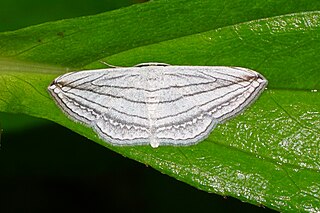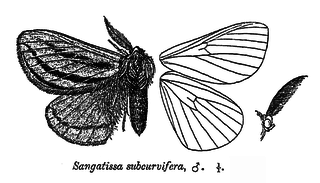Nolasena is a monotypic moth genus of the family Erebidae. Its only species, Nolasena ferrifervens, is found in India, Sri Lanka, Borneo and the Philippines. Both the genus and species were first described by Francis Walker in 1858.
Oxygonitis is a monotypic moth genus of the family Noctuidae. Its single species, Oxygonitis sericeata, is found in the Indian subregion, Myanmar, Sumatra, Peninsular Malaysia, Java, Borneo, the Philippines, Sulawesi, Australia and Sri Lanka. Both the genus and species were first described by George Hampson in 1893.

Amphitorna is a genus of moths belonging to the subfamily Drepaninae.
Spectroreta is a monotypic moth genus belonging to subfamily Drepaninae erected by Warren in 1903. Its only species, Spectroreta hyalodisca, was described by George Hampson in 1896.

Mnesiloba dentifascia is a moth of the family Geometridae first described by George Hampson in 1891. It is known from the Oriental tropics.

Blasticorhinus rivulosa is a moth of the family Noctuidae. It is found in Japan, Taiwan, India and Sri Lanka.

Oreta extensa is a species of moth of the family Drepanidae described by Francis Walker in 1855. It is found in China, Taiwan, India, Sri Lanka, Indonesia and Thailand.

Hypena obacerralis is a moth of the family Erebidae. It is found throughout Africa, the Middle East and South Asia and Malaysia.

Scopula opicata is a moth of the family Geometridae first described by Johan Christian Fabricius in 1798. It is found in tropical Africa, including Malawi and Zambia, as well as in Sri Lanka, India, China (Hainan), Myanmar, Sundaland, the Philippines, Sulawesi, Timor and New Guinea.
Gymnoscelis deleta is a moth in the family Geometridae. It is found in India, Korea, Japan, Taiwan and probably in Sri Lanka according to Hampson.
Spilarctia castanea is a moth in the family Erebidae. It was described by George Hampson in 1893. It is found in Sri Lanka.
Dodanga cristata is a moth in the family Crambidae. It was described by George Hampson in 1891. It is found in India and Sri Lanka.
Amphitorna albipuncta is a moth in the family Drepanidae. It was described by George Hampson in 1893. It is found in Sri Lanka.
Amphitorna olga is a moth in the family Drepanidae. It was described by Swinhoe in 1894. It is found in north-eastern India and China.

Nordstromia bicostata is a moth in the family Drepanidae. It was described by George Hampson in 1912. It is found in Sikkim in India, Sichuan in China, Nepal and northern Myanmar.
Oreta griseotincta is a moth in the family Drepanidae. It was described by George Hampson in 1893. It is found in China, Taiwan, north-eastern India, Sikkim, Malaysia and Singapore.
Phalacra excisa is a moth in the family Drepanidae. It was described by George Hampson in 1892. It is found in Sikkim, India.
Habrosyne plagiosa is a moth in the family Drepanidae first described by Frederic Moore in 1882. It is found in Sikkim, India.
Pseudojana pallidipennis is a moth in the family Eupterotidae. It was described by George Hampson in 1895. It is found in Myanmar and the north-eastern Himalayas.

Eupterote subcurvifera is a moth in the family Eupterotidae. It was described by Francis Walker in 1865. It is found in India and Sri Lanka.







